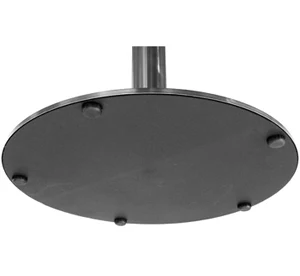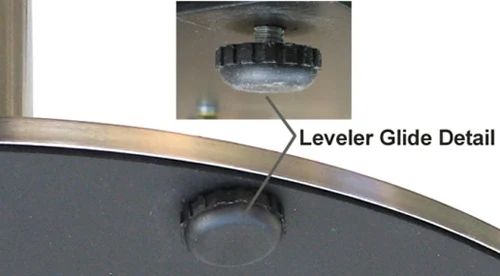Stainless Steel Table Base
With Wood Column
21 1/4" Diameter 304 outdoor grade 1mm thickness, #4 satin finish Stainless Steel Shroud Over A 5/16" Mild Plate Steel
Powdercoated Ballast Bottom.
3 Diameter Beech Wood Species Column, Natural, Clear Finish.
Adjustable Levelers On Table Base Underside. Dining Height Only. Bar Height Not Available.


21 1/4" Diameter with 3" Wood Column
Table Top Attachment Plate 11 3/4" X 11 3/4". Dining Height Shown. Bar Height Not Available.


Round Stainless Steel Table Base Bottom Underside And Adjustable Leveler Detail.



Use Base For Square And Round Table Tops. Beech Wood Column Natural Clear Finish Detail.
These 304 grade stainless steel table bases are very resistant to corrosive environments but do require periodic care and maintenance.
Cleaning is necessary on any grade stainless steel to prevent corrosive particles from gathering in the grain of the stainless steel surface.
Corrosive particle build-up results in a rust colored stain. One might think that the stainless steel is rusting but it is actually the corrosive particles
that are reacting and causing staining. Weekly cleaning with a good stainless steel cleaner will keep the stainless steel surfaces free from corrosive particles.
In environments where there is salt and or chlorine present weekly cleaning with water and liquid detergent followed by drying will keep the stainless steel surface
free from contamination.
If staining has already occurred the surface can be cleaned with a non abrasive kitchen "cream" cleanser.
The spider and the ballast plate are not stainless steel. We cannot guarantee these components against corrosion.
A protective spray and/or frequent drying is necessary if the table bases are to be left outside or used in a corrosive environment.
Mild steel is the most common form of steel as its price is relatively low while it provides material properties that are acceptable for many applications.
Mild steel has a low carbon content and is therefore neither extremely brittle nor ductile. It becomes malleable when heated, and so can be forged.
It is also often used where large amounts of steel need to be formed, for example as structural steel.